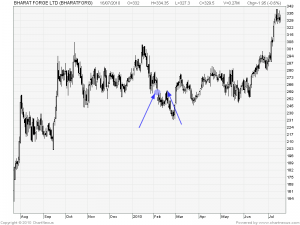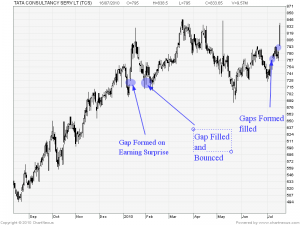
Today as i saw the trading move in TCS on earning surprise i thought of writing on gap trading as TCS you can find many gaps formed.
What is a Gap?
Change in price levels of a stock/index between close and open of two consecutive days. It can also be defined as a pattern where no trading has occurred.Gaps can form in any time frame,mostly are useful for swing traders.
Why Gaps are Formed?
- Gaps are formed to cause maximum pain to traders ie. maximum amount of loss to leveraged traders/short term traders.
- To keep people out of a major move so that we may see a follow through buying by amateur traders.
- Reaction of overnight news ie.Global cues from US,Europe and Asian Stock Market.
One of the famous Gap was formed on Nifty was on 20th May 2009 where We opened a Gap up of 20% because of a exceptional news on Formation of India Government at center.
I have also mentioned the Gaps with a Blue Circle on Daily charts.
Let have a look at opening gap down
Example is of Bharat Forge Stock Closed at 260.3 but the very next day opened at 258.3 and made a void or opening gap down of Rs 2
Filling The Gap
Now many times of Blogs/Newspaper/Business News Channel most of the readers have heard about of terms Filling the gap.What does this term indicates.Lets again have a look at TCS chart
In Blue circle i have mentioned the Gaps,there are almost 3 gaps formed by TCS on daily chart.
If we look at first gap which was formed when TCS gaped up from 719 to 728 on some good news and moved up to 800+ levels but it retraced back in few trading sessions and filled the gap.This is know as Filling the gap.
I have mentioned one more example of Filling the gap in TCS.Quite often, prices will retreat to fill a gap in a bull market before continuing the move. Likewise, prices often rally in a bear market to fill gaps.
All gaps are filled is not a trusim,Sometime gaps are never filled for years as The gap Nifty has formed on 20th May 2009 and till now it has not filled.
For trading purposes, we define four basic types of gaps as follows:
- Breakaway Gaps – Breakaway gaps often occur after a stretch of sideways trading . Most traders out of the move when these type of gaps occurs and usually precedes a major move. This type of gap may remain unfilled for a long period of time. In some cases these gaps may never get filled.The gap Nifty has formed on 20th May 2009 and till now it has not filled.
- Continuation Gaps – Sometimes called runaway gaps or measuring gaps, these occur during a strong advance in price.
- Exhaustion Gaps – This type of gap occurs in the direction of the prevailing trend and represents the final surge of buying or selling interest before a major trend change.



Dear Sir,
Unable to understand which data (i.e NS or NF) we should understand more reliable from technical point of view as no gap in NS & huge gapup in NF on 18th May, 2009.
Please clarify.
Dear Bramesh,
As per Nifty data up closing difference of 651.5 points (4323.15-3671.65) was observed on 18th may, 2009 and not on 20th may, 2009 as mentioned in your article.
Also Low/open price (3673.15) of 18th May was lower than the high price (3686.25)of the preceding trading day of 15th may, 2009. So in my opinion there exist no gap as per Nifty spot data.
Data of Nifty spot is given below for your reference from 14th may to 21st may, 2009.
Date Open High Low Close
May 21, 2009 4,270.35 4,319.00 4,199.20 4,210.90
May 20, 2009 4,318.75 4,362.85 4,244.70 4,270.30
May 19, 2009 4,324.95 4,509.40 4,167.65 4,318.45
May 18, 2009 3,673.15 4,384.30 3,673.15 4,323.15
May 15, 2009 3,597.85 3,686.25 3,597.85 3,671.65
May 14, 2009 3,631.90 3,631.90 3,537.60 3,593.45
Please clarify me, if I am wrong.
Thanks and regards.
Dear Sir,
Please repeat the same exercise on NF data.You will see the gap.
Rgds,
Bramesh